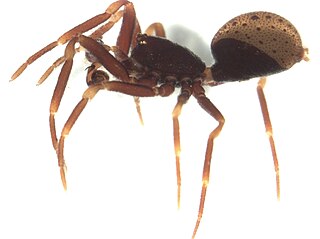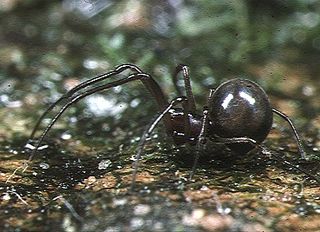
Desidae is a family of spiders, some of which are known as intertidal spiders. The family is named for the genus Desis, members of which live in a very unusual location — between the tides. The family has been reevaluated in recent years and now includes inland genera and species as well, such as Badumna and Phryganoporus. In 2017, the family Amphinectidae was merged into Desidae. The family Toxopidae has been separated off. Those intertidal spiders that are truly marine commonly live in barnacle shells, which they seal up with silk; this allows them to maintain an air bubble during high tide. They emerge at night to feed on various small arthropods that live in the intertidal zone.

The Agelenidae are a large family of spiders in the suborder Araneomorphae. Well-known examples include the common "grass spiders" of the genus Agelenopsis. Nearly all Agelenidae are harmless to humans, but the bite of the hobo spider may be medically significant, and some evidence suggests it might cause necrotic lesions. However, the matter remains subject to debate. The most widely accepted common name for members of the family is funnel weaver.

Amaurobiidae is a family of three-clawed cribellate or ecribellate spiders found in crevices and hollows or under stones where they build retreats, and are often collected in pitfall traps. Unlidded burrows are sometimes quite obvious in crusty, loamy soil. They are difficult to distinguish from related spiders in other families, especially Agelenidae, Desidae and Amphinectidae. Their intra- and interfamilial relationships are contentious. According to the World Spider Catalog, 2019, the family Amaurobiidae includes about 275 species in 49 genera.

Orsolobidae is a six-eyed spider family with about 180 described species in thirty genera. It was first described by J. A. L. Cooke in 1965, and was raised to family status from "Dysderidae" in 1985.

Malkaridae is a small family of araneomorph spiders first described by V. T. Davies in 1980. In 2017, the family Pararchaeidae was brought into synonymy with Malkaridae.

Stiphidiidae, also called sheetweb spiders, is a family of araneomorph spiders first described in 1917, Most species are medium size and speckled brown with long legs. All members of this family occur in New Zealand and Australia except for Asmea. They build a horizontal sheet-like web under rocks, hence the name "sheetweb spiders".

Anapidae is a family of rather small spiders with 231 described species in 58 genera. It includes the former family Micropholcommatidae as the subfamily Micropholcommatinae, and the former family Holarchaeidae. Most species are less than 2 millimetres (0.079 in) long.

Cambridgea is a spider genus in the family Desidae and some of the first endemic spiders described from New Zealand. They are known for constructing large horizontal sheet webs measuring up to a square metre in larger species. Cambridgea were originally assigned to the Agelenidae by Dalmas in 1917 but were reassigned to the Stiphidiidae in 1973. Most recently, both Cambridgea and sister genus Nanocambridgea were reassigned to the Desidae, subfamily Porteriinae on the basis of molecular evidence.
Hapona is a genus of South Pacific araneomorph spiders in the family Toxopidae, and was first described by Raymond Robert Forster in 1970. Originally placed with the intertidal spiders, it was moved to the Toxopidae in 2017.
Hulua is a genus of South Pacific araneomorph spiders in the family Toxopidae, and was first described by Raymond Robert Forster & C. L. Wilton in 1973. Originally placed with the intertidal spiders, it was moved to the Toxopidae in 2017.
Neomyro is a genus of South Pacific araneomorph spiders in the family Toxopidae, and was first described by Raymond Robert Forster & C. L. Wilton in 1973. As of May 2019 it contains only three species, all found in New Zealand: N. amplius, N. circe, and N. scitulus. Originally placed with the intertidal spiders, it was moved to the Toxopidae in 2017.
Ommatauxesis is a monotypic genus of Australian araneomorph spiders in the family Toxopidae containing the single species, Ommatauxesis macrops. It was first described by Eugène Simon in 1903, and has only been found in Australia. Originally placed with the Cybaeidae, it was moved to the intertidal spiders in 1967, and to the Toxopidae in 2017.
Toxops is a monotypic genus of Australian araneomorph spiders in the family Toxopidae containing the single species, Toxops montanus. It was first described by V. V. Hickman in 1940, and has only been found in Australia. Originally placed with the intertidal spiders, it was moved to the Toxopidae in 2017.
Toxopsoides is a genus of South Pacific araneomorph spiders in the family Toxopidae, and was first described by Raymond Robert Forster & C. L. Wilton in 1973. Originally placed with the intertidal spiders, it was moved to the Toxopidae in 2017.
Physoglenidae is a family of araneomorph spiders first described by Alexander Petrunkevitch in 1928 as a subfamily of Pholcidae. It was later moved to Synotaxidae until a study in 2016 showed that they formed a distinct clade.
Myro is a genus of araneomorph spiders in the family Toxopidae, and was first described by O. Pickard-Cambridge in 1876. Originally placed with the Cybaeidae, it was moved to the intertidal spiders in 1967, and to the Toxopidae in 2017.








